Last night I watched a movie I haven’t seen in years from a brand new blu-ray disk (thanks CEF!) on the big hi-def screen: Babette’s Feast.
This movie has it all.
I can say “everything” now because it is the Pope’s favorite film and it features a cuillère à sauce individuelle, a source of true delight. And since Pope Francis, with his low liturgical style is unlikely to use a scruple spoon, I surmise that the cuillère à sauce individuelle – which I saw in the movie – is the Pope’s favorite spoon. (Okay.. maybe a wooden spoon, but that doesn’t work for this post.)
See it? Sorry, these are snaps from my phone of the screen.
Since everything in Babette’s Feast is symbolic, what do we make of the sauce spoon?
Not much?
Au contraire!
“But Father! But Father!, you will immediately object, “The great final meal of the film is set around 1885. The cuillère à sauce individuelle was introduced in 1950.”
Yes. I wrote about that HERE. I have featured the CASI in posts about food HERE and HERE. So what?
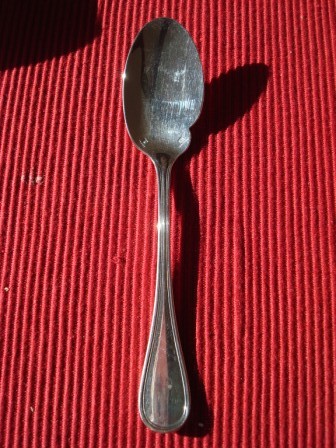 Lessons.
Lessons.
Pope Francis has a lower liturgical style which has liberals taking victory laps. They will say, “See? SEE?!? He is doing it just like the Apostles, in the pristine way before all the medieval accretions gummed up the works. He’s so humbly wonderful, so wonderfully humble….”
I respond saying that his liturgical style may be just as much as an anachronism as the appearance of the French sauce spoon in the Pope’s favorite movie Babette’s Feast.
Thus, perhaps the Pope is really trying to signal some quite different. He is actually saying “I might like ‘Ol-brot’, but Mass should be like what Babette made. Use the sauce spoon!”
The anachronistic sauce spoon in the Pope favorite movie proves it.
The next step. He might be turn Roman liturgy into Ol-brot, but what he really wants us to have is the final meal. What’s better for Mass? What she made or… “let it soak”.
BLECH.
Once the general uses it, during the last supper, and people see what it is for, they all use it too.
Okay… everyone… get out there are promote the older, traditional form of Holy Mass in that Latin Rite.
That’s what Francis would want! The sauce spoon in Francis favorite movie proves it. Go ahead and argue that it is anachronistic. That makes it even better.
Now I need to look up recipes for Cailles en Sarcophage! I might need serious donations to make that one, given the huge slices of black truffle.
By the way, at the end of the movie, the two sisters -like the disciples walking to Emmaus – recognize Christ (Babette is the self-emptying Christ-figure) not in the soaking of the ale-bread, but in the wreck of dirty dishes and the flotsam of the kitchen, and what they ate, and how their hearts burned within them … and through the use of the cuillère à sauce individuelle.
(Someday remind me to tell you about the meal during which we sucked the brains out of the heads of little birds.)

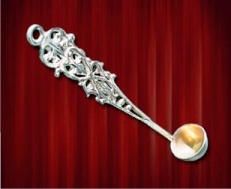
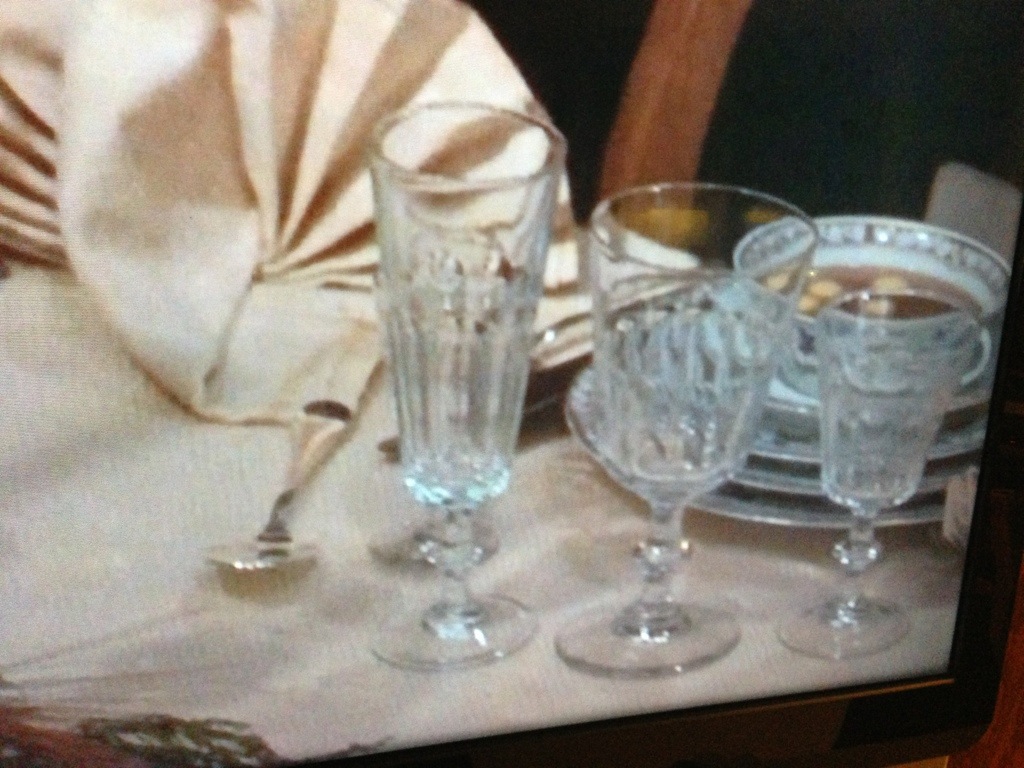
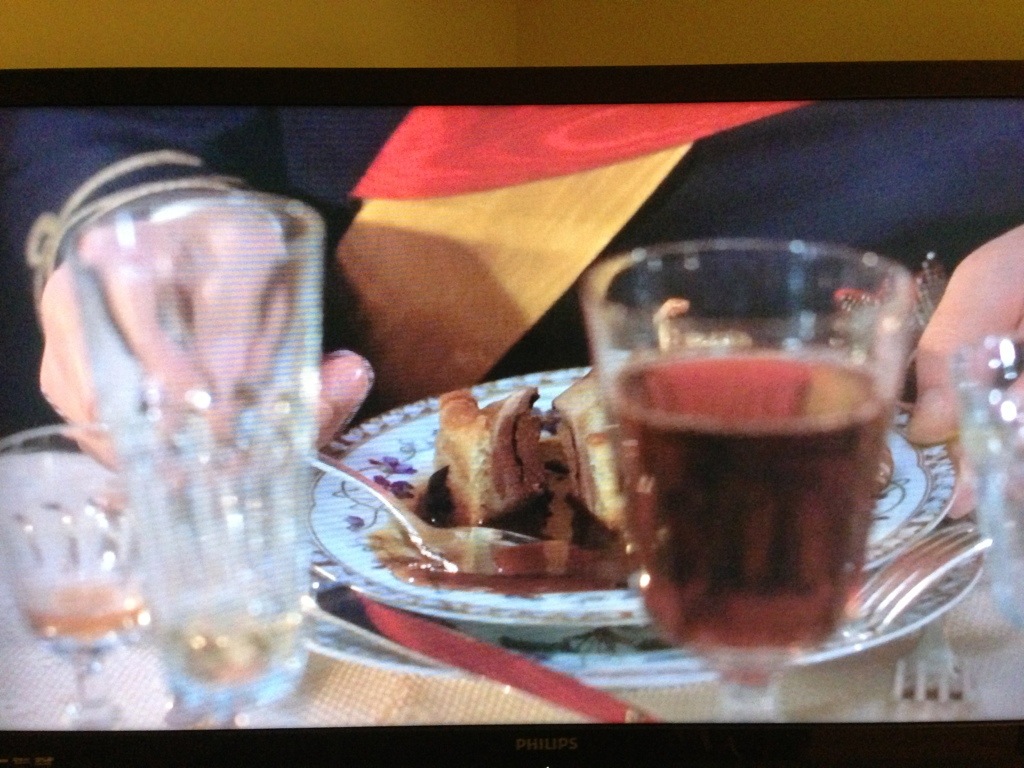
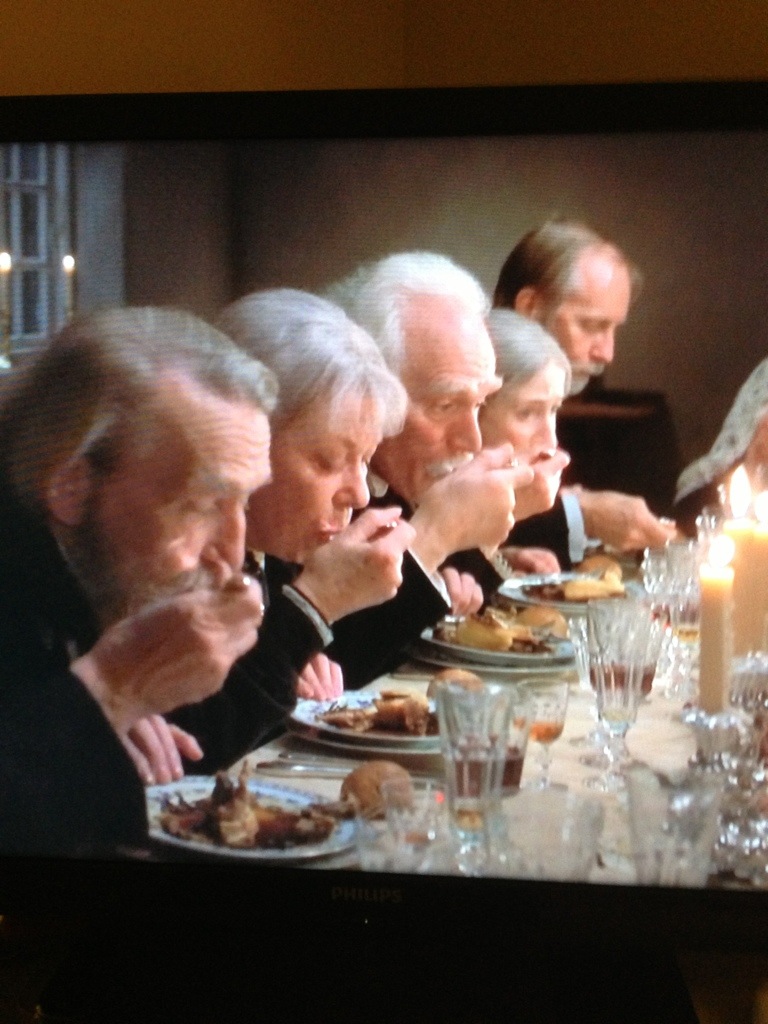

































Father, I seriously DO want to know about the birdie-brains.
Ortolans?
It was a seasonal thing.
And I was in a tiny town near Vicenza with US military and locals.
Really interesting story… someday I will tell it.
Thank you for reminding me of happier days when families actually had such silverware and used these. We also had special plates for bones. These were curved and set at the top of the plate. Here are examples. My family ones were much finer. http://i.ebayimg.com/t/Antique-Curved-China-Flowered-Bone-Dishes-five-in-set-Excellent-condition-/00/s/MTIwMFgxNjAw/z/Kd0AAMXQNOZRB~mM/$(KGrHqN,!oEFEDLkUdT0BRB+mMi!Vg~~60_57.JPG
Why we have lost the art of eating is one of the signs of decadence in our cultures. When people stop considering eating as a time for sharing conversation, manners and delighting in each other’s company over excellent food, we know the culture has died. How can we appreciate ceremony without daily rituals?
This reminder of the sauce spoon makes me both happy and sad. I had great Grandmothers who had all of these things, both the old and the new (new as in 1950s). We also had individual salt servers, which were small, crystal bowls, or even rectangular with or without very small matching spoons. In addition, we had individual butter dishes.
Setting the table for a meal took a while! I miss all of this and it is connected to how we approach the liturgy, whether one realizes it or not. If children, for example, are taught table etiquette and the usage of special tableware, they understand the TLM much better-I would say, naturally.
One other note. We always, and in my house as well, used napkins, and even cloth ones. I had many sets of napkins. I have been at restaurants in the past year which did not give napkins unless one requested these. Can you believe this?
During my formation in religious life we were made to watch the film, which was said to be the sublime height of eucharistic doctrine.
“Why we have lost the art of eating is one of the signs of decadence in our cultures. When people stop considering eating as a time for sharing conversation, manners and delighting in each other’s company over excellent food, we know the culture has died. How can we appreciate ceremony without daily rituals?”
I must admit I find this view VERY irritating.
First of all, at basic, we don’t eat food a few times each day for fun, but to ensure that our bodies have the energy and nutrients we need to live.
Second, I don’t recall any need that my family ever had for fancy dinnerware. Yes, we used “china” for Sunday meals sometimes, but we mostly used a simple knife, fork, and spoon for silverware with simple (probably plastic) plates and glasses. Even so, our conversations tended to be pretty vigorous, especially as we went through our teens.
Third, there’s a time and place for a formal dinner, but it’s not all the time and NOT every place. When I’m stuck having to think about putting on a cumberbund or a suit merely to consume food to give me energy for a few hours, we’re already getting close to being in the “not worth it” category. I think I’ve had a few meals where I had to worry so much about manners and decorum that I burned almost as much energy just getting through the blasted meal as I gained from eating in the first place!
I still don’t think of family meals as rituals actually; if we must hint in that direction, let’s at least be bothered to keep it to simple tableware, a prayer before the meal, and simple courtesies along those lines.
As to the deal about napkins, I’d comment that I don’t recall that we necessarily fooled with those at home; I’ve never seen an occasion when a napkin would actually stay in it’s assigned spot near my knee or on my lap. Fool thing almost always winds up on the floor. I’ve never understood why anyone thought they’d keep themselves cleaner with one. Seems to me you darn near have to be sitting as stiff as a statue for that to work.
“Setting the table for a meal took a while! I miss all of this and it is connected to how we approach the liturgy, whether one realizes it or not. If children, for example, are taught table etiquette and the usage of special tableware, they understand the TLM much better-I would say, naturally.”
Great point, Supertradmum. Reminds me of my early 60s childhood – Missa cantata or (less frequently) High Mass at 12:00 on Sunday, then lunch in the family dining room, for which my mother used the best table service, linen napkins, rings and all. Manners and ettiquette strictly observed, but not in a joyless sense – my parents were great fun basically, but you did THE RIGHT THINGS at THE RIGHT TME. Thus Sunday was seen to be a special day by us kids and we looked forward to it. In a sense the family meal was almost a seamless extension of the Mass, with its solemnity, decorum, rituals and sense of occasion. “Pass the salt, please”; “may I leave the table, please?” Important lessons were learned. Thankfully they have been passed on to the next generation (well, sadly, not the beautiful Masses but anyway).
“Eheu fugaces, Postume, labuntur anni…”
I think the sauce spoon is elitist and oppressive towards left-handers making sauces unreachable to us. I think we should do away with them and just use bread. Jesus wouldn’t have used a sauce spoon.
I understand what Supertradmum is saying about the use of table settings and fine fine china. I scored a deal on about $2000 worth of vintage fine china for only $100 (I luv Kijiji). To my surprise, there was also a box of 6 vintage lead crystal brandy snifters from Germany, each sell for around $40 a piece online right now. I got it out for Easter supper with my friends, did the full table setting that I remembered from when I was sent to “Etiquette School” to learn how to “be a lady”, and had felt quite thrilled that despite all of us being young, single, and far away from family, I was able to provide everyone with a delicious turkey supper in a beautiful eating environment. Before it was during these times I resented being all alone on family feasting occasions and bitter towards those who wouldn’t think of inviting those of us who are alone to join them. Now I’m just rambling, but I do take great joy in elaborate table settings and beautiful china rather than shoveling Kraft Dinner or Ramen Noodles out of a pot. However, I do find it tempting to judge those who don’t know the difference between their bread plate and salad plate (bread plate = top left salad plate = right of dinner plate, FYI).
I have all these things, sets of gold incrusted china and ditto sets of glasses, and embroidered linen and napkins, individual salt cellars and their spoons, to make the table give under the weight.
Maybe I should bring it all out even though all my teenage son seems to want is to eat and run…
Babette’s feast – I checked on You Tube – has so far bored me to tears, but I didn’t understad what it was about, I have to take another look.
I can honestly say that I have absolutely no idea what this post is about.
One of the themes of the movie is that Babette is Catholic and French, and everyone else is really low church Protestant and Dutch. So her feast is not only an education in foreign food, but the idea that meals can be not merely utilitarian, but joyful. It got the Academy Award for Best Foreign Film in 1987.
Adding to a discussion of meaningful foreign films, my favourite is Tree of Wooden Clogs, which I love and adore…as it were. I want to start a second blog called Tree of Wooden Blogs, but do not have the time…
This is one of my all time favorite films. However, it wasn’t until I became Catholic that I understood some of its deeper points. Made me smile in delight to hear that it is the Pope’s favorite film. I will make a point of watching it today…for the umpteenth time. It only gets better each time you see it. Looking out for the sauce spoon!
BTW, here is a feast–which could also inspire a future pope…
http://supertradmum-etheldredasplace.blogspot.co.uk/2013/04/seder-meal-2013.html
Wow, I thought I knew table etiquette because I had to explain to my fellow band members at band banquet why they had two forks, and what the “weird shaped” (butter) knife was. That and which spoon to use for tea/coffee and which for soup, oh and the concept of cutting the salad to bite sized pieces… went right over their heads (Though that may be due to drunkenness). But I have never seen ANY of these things at a dinner table ever. I’ve heard of them vaguely, but never seen them. If I’m called to marriage I want to bring some of these back with my family and will teach table etiquette to my children. Even the simple no phones at the dinner table is lost today. Or no hats. :(
Allen, me too, if I hadnt seen the movie.
fyi (after searching the internet) http://boards.straightdope.com/sdmb/archive/index.php/t-529506.html
aruvqan08-26-2009, 06:40 AM
Ol-brot [ale bread soup]Take dried fish [cod is almost ubiquitous in new england and many areas of the country] and stale rye bread, break both of them into pieces. Put the cod into warm water a few hours before preparing the soup to rehydrate. When it is time to make the soup, press the excess water out of the dried fish, and add the fish and bread to a pot with enough ale to cover. Simmer until the bread dissolves and the fish is rehydrated and cooked through.
Not sure if there is a real recipe online, just have seen it made enough times to know how to make it [first hubby was norwegian-english and it was a comfort food :eek:]
guans, Cod is no longer ubiquitous in New England, due to overfishing, most of the Cod you can buy here comes from Alaska :(
“(Someday remind me to tell you about the meal during which we sucked the brains out of the heads of little birds.)”
I’m shocked, I tell you…shocked. Was this a zombie meal? Did you feel like wandering around town muttering, “Brains…,”after the meal? Nightmares…
The Chicken
Well, Father, this certainly made my breakfast more interesting. One question. I stirred my coffee with a fork because I was out of spoons. What does this mean?
Southern Baron, you were either too lazy or too tired to wash spoons-that is the meaning!
Babette’s Feast also can readily be seen as The Last Supper. Watch it with that in mind as well.
The kinds and degrees of conversions evident in the faces of the guests during the feast are inspiring.
The lengths to which Babette must go in preparation for the feast are also instructive.
And I love that the feast is prepared in the holy of holies (kitchen) outside the nave (dining room) then carried out to the people
Also the young “altar server” who receives instructions from Babette in the kitchen and serves those at the table
Also the liturgical ORDER of the feast
Endless parallels. Beautiful film. Must see.
No, I think that General Butler stole my spoons in the night. It has been known to happen.
Southern Baron, lock up those silver spoons.
Have now seen the film on You Tube. NOT bored to tears anymore! (I had only seen the scene where they all sit and very hesitatingly eat and comment on the food.)
It’s charming!
Also the lovely 18th century interiors, so to the taste of us Scandiavians, were so nicely depicted.
Among my hoard of silver, including spoons for every type of dessert, I also have a special potato serving fork, the outer prongs (if that is le mot juste) have additional ‘spurs’ to grab the potato!
Öl-bröd, forsooth!
!
I was going to complain that this post was making me hungry, but the footnote cured that!
Still haven’t seen this film, but it sounds great. Hope to watch it soon.
FrCharles wrote, “During my formation in religious life we were made to watch the film, which was said to be the sublime height of eucharistic doctrine.”
I have this on dvd and have watched it and found it worthwhile. Properly understood with Fr. Z’s instruction, it can be seen as “grand liturgy.” However, on the cynical side, it can be used by simpletons who believe the Mass is nothing more than a meal and a sharing amongst believers. The Neocatechumenal Way comes to mind and their practice (condemned by the Holy See) of receiving Holy Communion while sitting down and in a home setting.
Is this really Pope Francis’ favorite?? It is mine too! I took a whole carload of friends to see it at an arthouse movie theatre during college. And, on Sunday mornings when I cook for the luncheon that follows our Latin Mass, I often wonder, “What would Babette cook?”!
acardnal, do you understand ART? It is mimesis, not poesis. It is a reflection of reality, not reality…As to simpletons, I do not think they would be inclined to see a foreign film. They would be lined up to see The Wrath of the Titans or The Dictator…do not get so serious, please.
Future_Sister,
You don’t have to be married to set fancy table settings and use nice china, and have table etiquette. We’re Catholic. We know how to do feasting. Next Solemnity, invite your Catholic friends over and throw a dinner party. Precede it by having the girls over for low tea. Oh, how I want to throw a low tea party while I still can.
I said low church and Dutch/should have written low church and Danish–oopsy.
LOVE+ that movie. I was filled with joy when I heard that Pope Francis liked it.
As a Lutheran convert to the Catholic Faith…this movie reminded me that I am (happily) a ‘Papist’. ;)
“(Someday remind me to tell you about the meal during which we sucked the brains out of the heads of little birds.)”
I’m just going to assume that this is a metaphor for “eviscerating the arguments of Fishwrap columnists.”
I would donate so you could take us step by step through Cailles en sarcophage—I could feast on the photos.
“As a Lutheran convert to the Catholic Faith…this movie reminded me that I am (happily) a ‘Papist’. ;)”
Same here : ) !
For every – yes, EVERY – evening meal our table is set with a cloth, napkins, a candle in the middle. No phone calls are taken, the tv is turned off, we give thanks. I don’t know what people use to wipe their mouths on if they don’t have napkins of any sort – maybe a sleeve? It is a ritual of ours, and for special occasions, the good china and silver makes itself known. We do this for the same reasons we have vestments and such in church, it is as much an offering of thanksgiving as that we offer for the food God provides us with. As for napkins ending up on the floor – maybe so with squirmy little kids, but surely an adult can tuck the top into a pant fold or whatever, sit still long enough not to dislodge it, unless they have ants in their pants? If we didn’t have any of these items, we wouldn’t approach our table with any less respect.
That last photo…
For some reason, it reminds me of the Vichyssoise flashback in Nunsense
Babettes Feast is one of the best! I often buy it as a confirmation gift to converts.
Does anyone here know how Karen Blixen came to write it? It’s a mystery to me why she did …
Jeanne, your description of your evening meals provides ample suggestion of why I’ve tended to frankly detest formal dinners. Maybe you wish to place ceremony of some sort in every larger meal you take. I, for one, do not. I’m much more concerned about being sure to have enough energy to get through several hours of living. I may need to do thus in many cases.
I said before that I think a fairly simple table setting quite adequate. I still think thus. If I need to have a more formal dinner with salad forks and such on occasion, that’s fine, but I’m not inclined toward an elaborate table setting with every meal. One single fork will readily accomplish what a fork needs to accomplish, as will one spoon and one knife. I don’t believe there’s any need to be concerned about cross-contamination between foods the way I would in a pizza store; I don’t believe there’s a critical need to pick up a salad leaf using a short fork one moment, then use a longer fork to hold a piece of meat in place for cutting five minutes later.
Some of these items strike me as being almost exclusively man-made rules, not something that’s going to take me heavenward–or otherwise.
As to sitting still and whatnot, I’d need to watch what you’re doing. In my experience though, napkins never stay where they’re intended. Even one little move can dislodge it.
Babette’s Feast: one of my all-time favorites since college! But I only saw it as an ingenious portrayal of Christ’s patience, humility, and self-expending love. His ocean of goodness and generous love so carefully reigned in and patiently awaiting the slightest opportunity to pour it out with His consummate skill and all the trappings to delight and yet to balance!
I was so taken with the above that I I hate to admit that I never caught the Eucharistic element in it! So now I’ll just have to watch it again (for the 7th time?). Gee darn!!
My dullness never ceases to amaze me. Thank God for this blog!
If you liked this movie, may I suggest another one? Ostrov (The Island) is a Russian movie about an Eastern Orthodox monk who….Well, I don’t want to give the plot away. It’s different from Babette’s Feast, but equally magnificent imho.
Thank you so much. This blog is often an education for me.
The other day I was talking to a friend about the pastor emeritus of my parish when i was growing up. He was a wonderful, saintly man who said the N.O. Mass with such care and dignity.
I tried describing to my friend the fact that this Msgr. Had a little spoon that hooked on the burse and was used for putting the water in the wine. Never saw one before and have never seen one used since and had no idea what it was called.
Scruple Spoon has now been added to my vocabulary of church terms.
Thanks again.
This is one of my all-time favorite pictures. I’m so glad that Pope Francis loves it (and Fr. Z.) as well.
Fr. Z your experience makes me think of that program Bizarre Foods. Bird brains qualify. I would have to be VERY hungry, as in, about to die hungry.
Babette’s Feast I always get confused with that movie, something about “Chocolate”, can’t remember the whole title. Like Water for Chocolate? I probably have that wrong. But it was about food I think. Love period films. Love foreign films. Love films that glorify God, the Church, the faith in some way. I still love films that many here might find “schmaltzy” such as “The Bishop’s Wife”. Schmaltz has it’s place.
It would be interesting to gather some wisdom here on films that you have found spiritually uplifting or interesting, Fr. Z., as well as the opinions of commenters here. There is a dearth of good films today. It would be nice perhaps to dig up some good classics or oldies. I would not have known Babette’s Feast was really a comparison to Jesus and the Mass.
Great movie! If you haven’t seen it, you got to see it.
Babette’s Feast (1987), by Steven D. Greydanus.
@netokor
I just saw “Ostrov” for the first time recently. It IS very good and I recommend it also but I would still have to rank “Babette’s Feast” above it for the number of themes present, character interplay, and how the whole thing builds.
Hi q7swallows, both movies are very subtle and rich in themes and symbolism. I have watched them many times and have always discovered a new lesson or insight. I am glad you also liked Ostrov. I am so much like Father Job (Ostrov) that I sympathize with his terrible struggle.
A few years back we had an inspired by Babbette’s Feast dinner for friends. Turtle soup from Bookbinder’s; blini romanov (smoked fish rather than caviar); quails in puff pastry (no heads, pepperidge farm pastries); pate with truffles; Rum Babka. And all the wine types but American: Oregon Pinot Noir, California Sparkling, New York Sherry (not great) and California brandy (Germaine-Robin).
The coffee? Mystic monk (naturally!)
Good comments. I jotted all the films mentioned.
Grabski, you know how to live.
Oh crikey. I just realized I mentioned the wrong movie. A few comments back I commented I always got confused between Babette’s Feast and another movie, and couldn’t think of the name. I thought it was “Like Water for Chocolate” but as usual, I’m off. It was the apparently much, MUCH tamer “Chocolat”, another foodie film, but quite different, I’m sure. I liked Chocolat enough, and have not seen the other. Not that it matters, but R movies are usually too something for my taste.